No, Apple's new Mac Pro isn't overpriced
That $53,000 for the Mac Pro on the high-end is a lot of money for a computer, but there will be buyers. There doesn't seem to be a lot of discussion about the lower, more practical, workstation price points -- which are common to Windows workstations too.
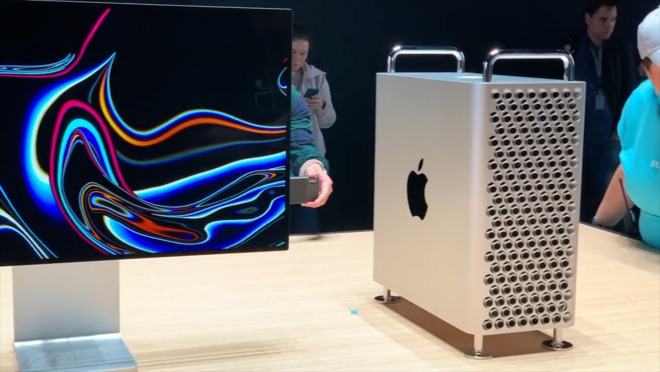
Mac Pro and Pro Display XDR
When considering the Mac Pro price, context is key. Context is what's lacking in nearly all of these conversations. If the Mac Pro is compared to build-your-own hardware or an iMac, it is indeed more expensive.
But, compared to Windows workstation pricing, the jokes and arguments fall flat.
The Mac Pro isn't a consumer-level machine that is actively competing with Apple's other Macs for the target market. The Mac Pro is a true professional workstation designed for the likes of Pixar, Adobe, and other organizations.
Titles like "Apple's priciest Mac Pro costs $52,599 -- 56% higher than typical U.S. income" from CBS News is comparing the maxed-out configuration against the median family income, as if that was the target audience Apple was trying to sell the Mac Pro to. The headline isn't factually incorrect, but it is a ridiculous compare point.
The machine has user-accessible RAM. Using non-Apple Storage or third-party AMD video cards aren't a major crisis, as the unit has eight PCI-E slots. There are already options for internally mounting drives in an MPX bay or connected to one of the two SATA-3 ports internal to the machine.
Users have balked, and cracked jokes at the $400 Apple chooses to charge for wheels, yet don't think twice -- or even consider -- the $309 Microsoft charges for the operating system on a Windows workstation. And, when they pick components from Newegg or other PC vendors to compare, that Windows price isn't included.
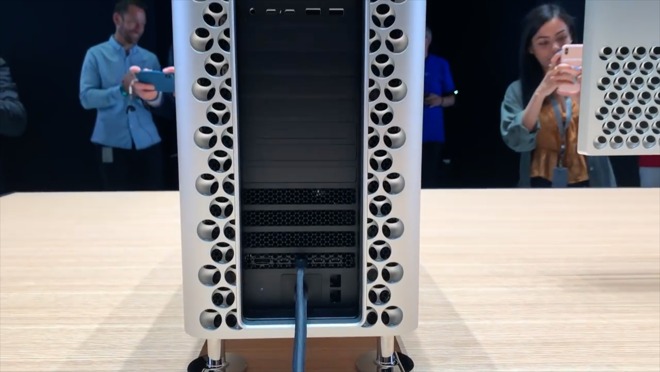
The back of the 2019 Mac Pro
If you don't want to pay Apple's prices for RAM, storage, and video cards, then don't -- this is a pretty straightforward concept. Big business and others not interested in spending labor and money will pay Apple's prices, though, and they'll pair the machine with an expensive service contract, well above and beyond just the $299 for AppleCare.
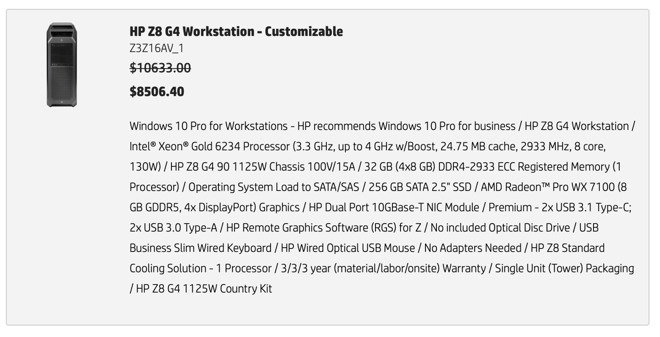
Comparing a similarly configured HP workstation to the entry-level Mac Pro
Looking at HP, we built a comparable tower with an Intel Xeon 6234 3.3GHz 8-core processor, 32GB (4x8GB) RAM, 256GB SATA SSD, and AMD Radeon Pro WX 7100 graphics with 8GB of memory. That is up against the Mac Pro base config with an 8-core 2.5GHz Xeon W processor, 32GB RAM, Radeon Pro 580X with 8GB of video RAM. The processors have similar real-world performance, and the WX 7100 and 580X video cards have similar performance with 4,150 gflops for the former and more than 5530 gflops for the latter.
The Mac Pro is effectively $6000. The HP, on the other hand, is a hefty $8,506.40 -- and that is on sale from the full price of $10,633. The HP still lacks features such as Thunderbolt, explicit support for 6K displays like Apple's Pro Display XDR, and more nebulously, Apple's design elements, like a near-silent case.
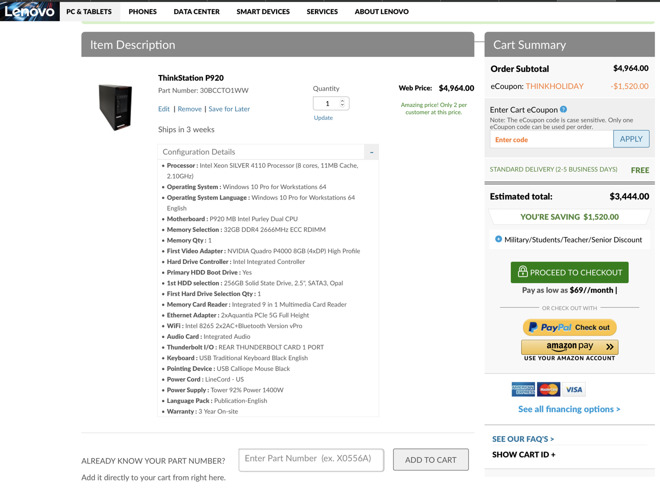
Comparing a similarly configured Lenovo workstation to the entry-level Mac Pro
Lenovo fared a bit better. A Lenovo workstation with Intel Xeon Silver 4110 8-core processor, 32GB of RAM, NVIDIA Quadra P4000 8GB graphics, and one Thunderbolt 3 port will cost $4,964 -- though it too is on sale for the holidays at $3,444. The Lenovo model lacks many features of the Mac Pro, such as more Thunderbolt 3, USB-C, dual 10Gb Ethernet, and, again, Apple's design elements.
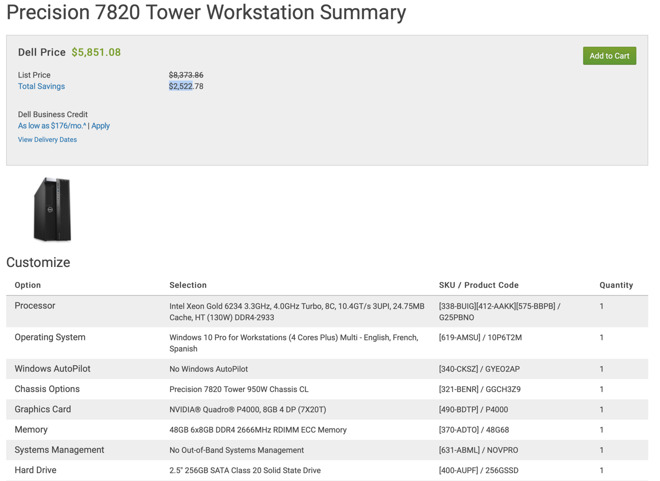
Comparing a similarly configured Dell workstation to the entry-level Mac Pro
A Dell workstation with an Intel Xeon Gold 6234 3.3GHz 8-core processor, 48GB RAM, NVIDIA Quadro P4000 with 8GB of memory, and two Thunderbolt 3 ports racked up the cost to $5,851 -- after $2,522 in holiday savings. Nearly the same price, but without many of the Mac Pro's benefits.
Most of that $53,000 in the Mac Pro is RAM and SSD upgrades at Apple's pricing. If we take out Apple-provided SSD and RAM -- which can be picked up aftermarket for less -- but max out the graphics and processor, we wind up with a $23,799 machine, with the 2.5GHz 28-core Intel Xeon W. We configured another HP workstation with similar specs, and it reached $22,150, on sale from its full $27,688 price point.
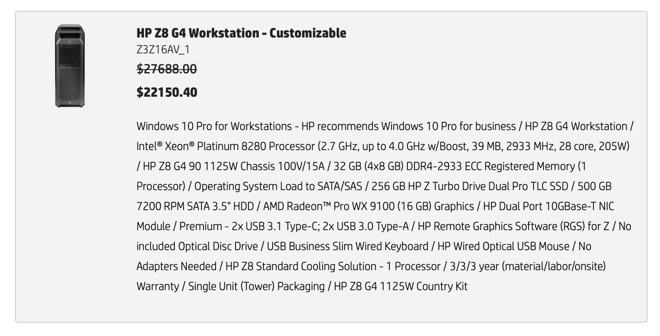
Comparing a similarly configured HP workstation to the high-end Mac Pro
That HP configuration also lacks Thunderbolt 3, and only packs a single AMD Radeon Pro WX 9100 with 16GB of memory. The Mac Pro, which costs far less at full price, is configured with two Radeon Pro Vega II Duo cards with 2x32GB of HBM2 memory each. You can add a second graphics card to the HP workstation, but it can only handle two WX 7100 cards rather than two WX 9100 cards.
Apple's Mac Pro isn't just priced competitively in the workstation market but comes in under the cost of many competing Windows-based offerings.
The Mac Pro is absolutely a "Pro" machine. It is also absolutely not for everybody, and absolutely not aimed at the same markets that the lower-end of the G4 towers or lower-end Mac Pro towers were. Comparing prosumer hardware like the low-end G4 or lower-end Mac Pro with a workstation is a strange comparison to make, but it's being made anyway.
And, for some reason, the jokes and Twitter hot-takes aren't talking about Windows workstation pricing, which, as we've demonstrated, are in the same range. The comparisons to Apple's pricing are derived using part-pickers, component by component. Assembly labor and support of a Frankenstein configuration aren't free, and the value of both varies person to person.

Apple's Mac Pro is well priced
The comparisons across the web today are omitting features, most commonly Thunderbolt 3. Comparisons are skipping the quiet enclosure and discounting the desire for macOS on workstation hardware. Just because you don't need something doesn't mean that it should be stricken from the compare.
We've said it before, Apple didn't set out to make that xMac of lore with Core i3, i5, i7, and i9 options, and just overshoot that target with the Mac Pro. The new Mac Pro is a workstation. While we won't argue that the xMac concept would be nice for us, and probably most of the AppleInsider audience, Apple set out to put the most processing power in the chassis they could, and they hit that target.
Now that it's available for purchase, it's even plainer to see that the new Mac Pro is aimed precisely at who the $9,900 Mac IIfx was targeted back in the day, who $6199 Xserve hardware was tailored for, and who the $3299 G5 quad-core in 2005 was sold to. The new Mac Pro is intentionally the biggest and beefiest computer that Apple has made since that IIfx, and that's a good thing overall.

Mac Pro and Pro Display XDR
When considering the Mac Pro price, context is key. Context is what's lacking in nearly all of these conversations. If the Mac Pro is compared to build-your-own hardware or an iMac, it is indeed more expensive.
But, compared to Windows workstation pricing, the jokes and arguments fall flat.
The Mac Pro isn't a consumer-level machine that is actively competing with Apple's other Macs for the target market. The Mac Pro is a true professional workstation designed for the likes of Pixar, Adobe, and other organizations.
Titles like "Apple's priciest Mac Pro costs $52,599 -- 56% higher than typical U.S. income" from CBS News is comparing the maxed-out configuration against the median family income, as if that was the target audience Apple was trying to sell the Mac Pro to. The headline isn't factually incorrect, but it is a ridiculous compare point.
Why the Mac Pro is expensive
Most of that $53,000 price point is in 8TB of flash memory and 1.5TB of RAM. Apple's RAM price alone is $25,000. Another $10K can go to two Radeon Pro Vega II Duo cards, sold for $5,600 individually. Tack on a massive 8TB SSD, a 28-core processor, and an Afterburner card, and it is easy to see how, when maxed out, this machine surpasses the $50k mark.The machine has user-accessible RAM. Using non-Apple Storage or third-party AMD video cards aren't a major crisis, as the unit has eight PCI-E slots. There are already options for internally mounting drives in an MPX bay or connected to one of the two SATA-3 ports internal to the machine.
Users have balked, and cracked jokes at the $400 Apple chooses to charge for wheels, yet don't think twice -- or even consider -- the $309 Microsoft charges for the operating system on a Windows workstation. And, when they pick components from Newegg or other PC vendors to compare, that Windows price isn't included.

The back of the 2019 Mac Pro
If you don't want to pay Apple's prices for RAM, storage, and video cards, then don't -- this is a pretty straightforward concept. Big business and others not interested in spending labor and money will pay Apple's prices, though, and they'll pair the machine with an expensive service contract, well above and beyond just the $299 for AppleCare.
Apple's Mac Pro versus Windows workstation prices
Workstations have always been expensive. The Mac Pro is no exception to that rule, and Windows workstations are priced similarly to the Mac Pro.
Comparing a similarly configured HP workstation to the entry-level Mac Pro
Looking at HP, we built a comparable tower with an Intel Xeon 6234 3.3GHz 8-core processor, 32GB (4x8GB) RAM, 256GB SATA SSD, and AMD Radeon Pro WX 7100 graphics with 8GB of memory. That is up against the Mac Pro base config with an 8-core 2.5GHz Xeon W processor, 32GB RAM, Radeon Pro 580X with 8GB of video RAM. The processors have similar real-world performance, and the WX 7100 and 580X video cards have similar performance with 4,150 gflops for the former and more than 5530 gflops for the latter.
The Mac Pro is effectively $6000. The HP, on the other hand, is a hefty $8,506.40 -- and that is on sale from the full price of $10,633. The HP still lacks features such as Thunderbolt, explicit support for 6K displays like Apple's Pro Display XDR, and more nebulously, Apple's design elements, like a near-silent case.

Comparing a similarly configured Lenovo workstation to the entry-level Mac Pro
Lenovo fared a bit better. A Lenovo workstation with Intel Xeon Silver 4110 8-core processor, 32GB of RAM, NVIDIA Quadra P4000 8GB graphics, and one Thunderbolt 3 port will cost $4,964 -- though it too is on sale for the holidays at $3,444. The Lenovo model lacks many features of the Mac Pro, such as more Thunderbolt 3, USB-C, dual 10Gb Ethernet, and, again, Apple's design elements.

Comparing a similarly configured Dell workstation to the entry-level Mac Pro
A Dell workstation with an Intel Xeon Gold 6234 3.3GHz 8-core processor, 48GB RAM, NVIDIA Quadro P4000 with 8GB of memory, and two Thunderbolt 3 ports racked up the cost to $5,851 -- after $2,522 in holiday savings. Nearly the same price, but without many of the Mac Pro's benefits.
Most of that $53,000 in the Mac Pro is RAM and SSD upgrades at Apple's pricing. If we take out Apple-provided SSD and RAM -- which can be picked up aftermarket for less -- but max out the graphics and processor, we wind up with a $23,799 machine, with the 2.5GHz 28-core Intel Xeon W. We configured another HP workstation with similar specs, and it reached $22,150, on sale from its full $27,688 price point.

Comparing a similarly configured HP workstation to the high-end Mac Pro
That HP configuration also lacks Thunderbolt 3, and only packs a single AMD Radeon Pro WX 9100 with 16GB of memory. The Mac Pro, which costs far less at full price, is configured with two Radeon Pro Vega II Duo cards with 2x32GB of HBM2 memory each. You can add a second graphics card to the HP workstation, but it can only handle two WX 7100 cards rather than two WX 9100 cards.
Apple's Mac Pro isn't just priced competitively in the workstation market but comes in under the cost of many competing Windows-based offerings.
Apples to oranges
The Mac Pro isn't just a $400 i9 processor jammed in a machine with a plain-as-day Northbridge, a few PCI-E slots, and a couple of I/O options. Instead, the Mac Pro is a machine where processors by themselves can cost thousands of dollars, coupled with other components running into the thousands of dollars each, all aimed at a very specific, very demanding, market.The Mac Pro is absolutely a "Pro" machine. It is also absolutely not for everybody, and absolutely not aimed at the same markets that the lower-end of the G4 towers or lower-end Mac Pro towers were. Comparing prosumer hardware like the low-end G4 or lower-end Mac Pro with a workstation is a strange comparison to make, but it's being made anyway.
And, for some reason, the jokes and Twitter hot-takes aren't talking about Windows workstation pricing, which, as we've demonstrated, are in the same range. The comparisons to Apple's pricing are derived using part-pickers, component by component. Assembly labor and support of a Frankenstein configuration aren't free, and the value of both varies person to person.

Apple's Mac Pro is well priced
The comparisons across the web today are omitting features, most commonly Thunderbolt 3. Comparisons are skipping the quiet enclosure and discounting the desire for macOS on workstation hardware. Just because you don't need something doesn't mean that it should be stricken from the compare.
We've said it before, Apple didn't set out to make that xMac of lore with Core i3, i5, i7, and i9 options, and just overshoot that target with the Mac Pro. The new Mac Pro is a workstation. While we won't argue that the xMac concept would be nice for us, and probably most of the AppleInsider audience, Apple set out to put the most processing power in the chassis they could, and they hit that target.
Now that it's available for purchase, it's even plainer to see that the new Mac Pro is aimed precisely at who the $9,900 Mac IIfx was targeted back in the day, who $6199 Xserve hardware was tailored for, and who the $3299 G5 quad-core in 2005 was sold to. The new Mac Pro is intentionally the biggest and beefiest computer that Apple has made since that IIfx, and that's a good thing overall.



Comments
Would you believe that any person goes to bed at night with concerns about the cost of the Mac Pro. Of course not, that is beyond silly.
The Mac Pro provides no guidance on future computer prices from Apple, or in anyway has an impact on the lives of ordinary people. It's an expensive computer to serve an audience who 1. asked for it, and are 2. now buying it.
With all due respect, I disagree. AI has presented the new Mac Pro, however in nuanced terms, as an article for consumers and not a workstation for professionals. Two examples: AI posted an article about where to get and how to install third party RAM on the Mac Pro to avoid paying Apple for outrageous RAM prices. Why would a pro do that? As a consumer I would easily consider that. But not a pro working for an agency. And two. You are quick to rationalize for Apple re: the $500 wheels by listing Windows operating system as a similar $500 add on. You know that’s not the same thing.
That of course would make for good clickbait but of course there wouldn’t be the countless youtube personalities piling on.
I am so sick of whining about $400 wheels and $1000 stands.
Needless to say my old cheese krater MacPro is still in use as a media server. I guarantee you any HP I would have bought in 2010 would have leeching toxins into a waste dump by now.
People are morons.
That's an...interesting...perspective. Not one I think is supported by the majority of AI copy, however.
Also, here's a guy who would install his own RAM -- a semi-pro photographer I know who ordered the new MP. He's not a big agency or studio, just a guy. Why shouldn't he be curious about how easy it is to install RAM? Being a pro doesn't mean you don't care about money whatsoever...it just means you know this is a tool that serves the purpose of making more money.
And you're right, well-engineered $400 wheels aren't the same as a $300 digital OS license that is copied millions of times over and incurs essentially no per-unit cost. If anything, the digital OS license should cost nothing compared to physical items. (See macOS -- cost is....$0).
100% of professionals are looking for a powerful computer that they can upgrade/expand over time.
99.99% of professionals did not ask for this extremely expensive specific video editing computer.
99.99% of professionals will not buy this extremely expensive specific video editing computer.
Therefore - the Mac Pro is in every way overpriced for the professional market.
Pointing to the .02% of professionals who might want this and making an argument in their support while ignoring pretty much the entire market... that's a stretch.
We are also buying a windows box to start looking into migrating as many other agencies already have.
After 26 years - it looks like Apple will be shown the door if they don't release a proper Mac for professionals that serves Small/Medium sized businesses in the next 3 years. (After these iMac have been written down).
There is no excuse for Apple to cater to .001% of the market and claim "There you go - we love Pro's seeeeee..."
It's such a massive 'miss' that we are seriously looking at Windows.
With a couple of high-end video cards, 8 TB of NVMe storage (that appear to rate slightly under the single GPU Radeon Pro Vega II) - was able to hit around $90,000 USD with holiday "sales" bringing it down from $111,000 or so. And that wasn't even all of the options that could be installed that would bring the price to it's maximum.
https://appleinsider.com/articles/19/06/04/editorial-the-new-mac-pro-is-overkill-for-nearly-everybody-and-it-hit-apples-own-target
A solo professional, or small video studio will buy the Mac Pro, and install their own RAM. Pixar, Disney, and the like will not. Neither are consumers, and both are who the Mac Pro is aimed at.
I agree that looked at as objects, the wheels and the cost of Windows aren't the same thing. However, looked at as an argument why the Mac Pro is expensive because this optional thing is $400 and a Windows Workstation is cheap if you don't include the cost of the required Windows install is the point of the exercise.